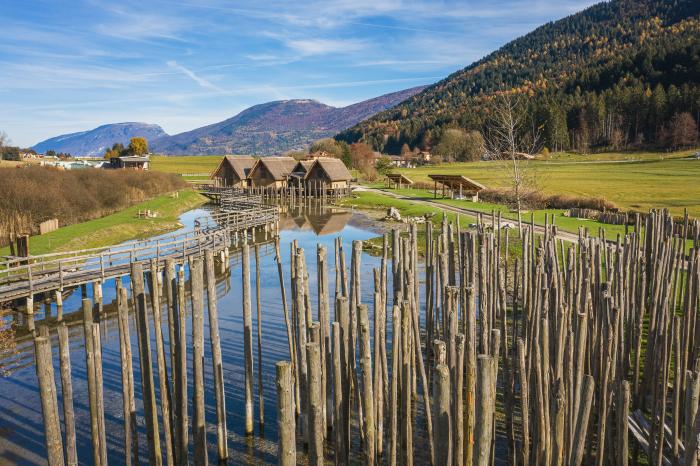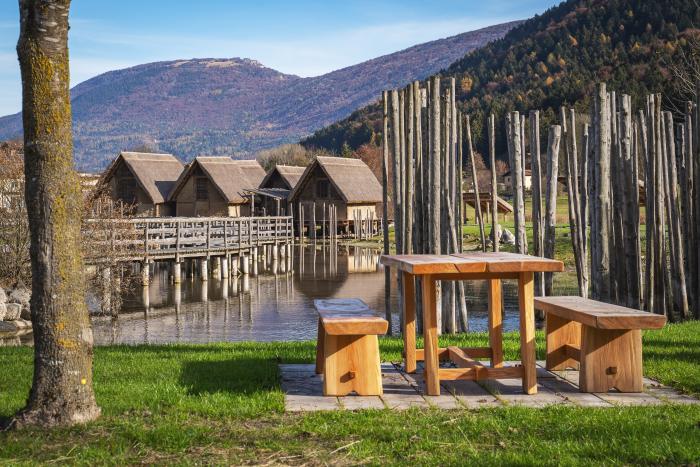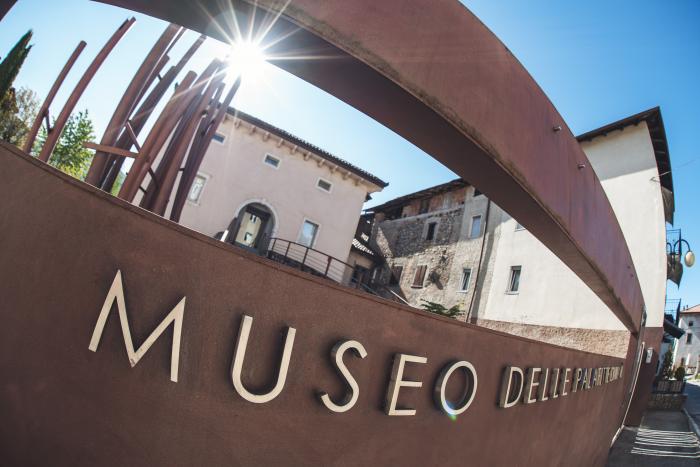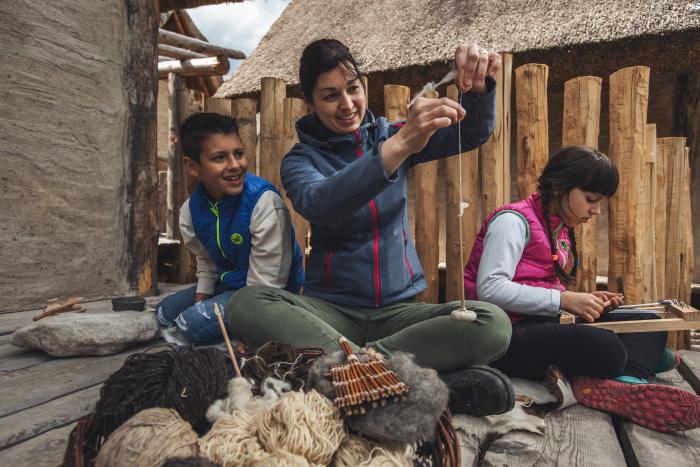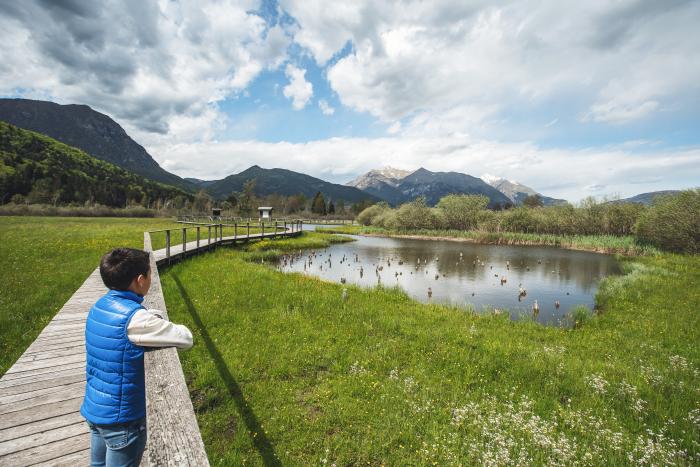I. SUMMARY INFORMATION
Project
268114
Status
Submitted
Award category
Preserved and transformed cultural heritage
You want to submit
NEW EUROPEAN BAUHAUS AWARDS : existing completed examples
Project title
Parco Archeo Natura - P.A.N.
Full project title
Archeo Nature Park: an open air museum in Fiavé - Trentino
Description
Inspired by criteria of sustainability, inclusion and participation, Parco Archeo Natura is an open air museum in Fiavé, Northern Italy. Visitors can live an immersive experience, watching the original submerged prehistoric pile dwellings of the UNESCO site in the protected natural area, visiting the reconstruction of the pile-dwelling villages on a 1:1 scale, as close as possible to the reality of the excavation documentation, and deepening their knowledge at the Museum in the center of Fiavé.
Where was your project implemented in the EU?
Italy
Trentino Alto Adige
Fiavé località Torbiera
46°0'16"20 N
10°50'38"40 E
Fiavé
38075
When was your project implemented?
Has your project benefited from EU programmes or funds?
No
Which programme(s) or fund(s)? Provide the name of the programme(s)/fund(s), the strand/action line as relevant and the year.
II. DESCRIPTION OF THE PROJECT
Please provide a summary of your project
Inspired by criteria of sustainability, inclusion and participation, Parco Archeo Natura – P.A.N.(Archeo Nature Park) is an an open-air museum in a natural and archaeological site in Fiavé, Trentino, a Northern alpin province of Italy, on which insist three UNESCO lists: World Cultural Heritage “Pile-dwelling sites around the Alps”; World Natural Heritage “Dolomiti-Dolomites”; Man and Biosphere Reserve “Alpi Ledrensi and Judicaria”.
P.A.N. is a cultural sytem composed of:
the UNESCO prehistoric original site in a protected natural area, where visitors can still observe the submerged prehistoric pile dwellings
the pile-dwelling Museum which is opened since 2012 in the center of the village of Fiavé
the new archeo nature park with the reconstruction on a 1:1 scale of the pile-dwelling villages, as close as possible to the reality of the excavation documentation
Hence visitors have the opportunity to follow an educational itinerary with an experiential and emotional tour in the open sites, that offers a didactic path of immersive and emotional impact, and enrich their knowledge with more detailed information and the original archaeological finds conserved in the Museum. Visit is fully accessible to the disabled and the reconstructions are also digitized for a complete immersion in the history.
P.A.N. will open in June 2021 but it’s first idealization was on the Seventy’s of the last Century after a long archaeological excavation session in the site of Fiavé, recognized as one of the most important Bronze age pile-dwellings site in Europe, where was involved many volunteers among the young people of the area.
The project was financed by public resources by Autonomous Province of Trento. For the governance of the P.A.N. the Province is involving public bodies as Municipality of Fiavé, and also private organizations, with the aims to increase social and economic development in an internal area and to involve young people in the management.
Please give information about the key objectives of your project in terms of sustainability and how these have been met
P.A.N. aims at increasing sensitivity and awareness of the value of cultural and natural heritage as non-renewable elements to ensure its full enjoyment by the local community and the visitors fostering also territory attractiveness with positive social-economic impacts, increasing awareness about the wealth of such heritage.
Thanks to the excavations and the important discoveries, the peat bog has been preserved and the project of the reclamation of the swamp area for intensive agriculture of corns has been abandoned.
The reconstruction of the prehistoric village, opened in 2021, was made with organic material as peat and dung, local woods, that guarantee a low environmental impact in the prospective of a green and slow enjoyment.
To develop a sustainable management model of public heritage which will foster the participation of the local community, an important Act has been approved by the council of the Province of Trento, Municipality of Fiavé, environmental protection public offices, enterprises involved in the tourism sector and its promotion, public economic operators, after a long work involving the main stakeholders.
Private organizations are involved in the future management allows the project to have a higher sustainability: quicker decision-making process, less legislative obstacles, higher innovation potential, direct link with the local community. The goal is to achieve public-private management within three years, sustainable with ticketing and laboratory revenues. To generate new job opportunities are organized educational workshops, exhibitions,events,meetings, etc, to giving value to local products like cheeses, honey, etc...
To promote a sustainable tourism, the local communities of the whole territory work together involving in particular the tourism of the Alto Garda territory, but make attention to maintain a slow and green approach. In Fiavé there're no large accommodation facilities and no intention of expanding the overbuilding.
Please give information about the key objectives of your project in terms of aesthetics and quality of experience beyond functionality and how these have been met
P.A.N. is near to the excavation archaeological area where visitors can still observe the submerged pile dwellings. The main aesthetics experience is good describes in the outstanding universal value acknowledged by UNESCO for the 111 sites of the international serial World Heritage Site “Prehistoric pile-dwellings around the Alps”:
“The series of p.d. sites are one of the most important archaeological sources for the study of early agrarian societies in Europe between 5,000 and 500 BC. The waterlogged conditions have preserved organic matter that contributes in an outstanding way to our understanding of significant changes in the Neolithic and Bronze Age history of Europe in general, and of the interactions between the regions around the Alps in particular”.
Visitor’s experience should not be limited to a journey in the past thanks to the reconstructed village and the visit to the archaeological excavation area, but is should be enlarge to a journey in nature with an itinerary in the evocative landscape of the Natural Reserve. Indeed the Department for sustainable development and protected areas of the Autonomous province of Trento has created a path with several informative panels about the flora and fauna of the peat bog. The area is a Natura 2000 Site of Community Importance (SCIs) as Special Areas of Conservation (SACs) for the for the bird species that nest there.
P.A.N is located in the perfect place to enjoy the landscape and a meditative journey in the post-covid era. Visitors can complete the experience in the Museum for educational workshop to know the ancient history in contact with original finds. But they can also taste local genuine products, walk inside the valley, ride bikes, horses and donkeys.
To have an idea of the site, visitors can also enjoy the visit at home thanks to an internet platform with an AR reconstruction of the prehistoric pile-dwelling villages, just realized by an important research institute in Trento (FBK foundation)
Please give information about the key objectives of your project in terms of inclusion and how these have been met
Inclusion is therefore a key element of P.A.N.
> In terms of accessibility:
P.A.N. has the Family brand released by the autonomous Province of Trento. It means that families are welcome, there are changing tables, economic offers for family, special Guest cards, all is designed for the wellness of children and youths;
the path is accessible in wheelchair, pushchair;
inclusive benches designed for disabled people;
cooperatives for the integration of disadvantaged workers realized some woods reconstructions in the park and the green areas;
some workshops are also designed for mental disabilities, such as “T-essere memorie" (“to be” and “to weave” memories) for Alzheimer patients, created by the Educational staff of the Archaeological Heritage Office of the Province of Trento, winner of the international ICOM award “Museum for all” in 2016.
> In terms of geography: the park is located in a remote mountain area. It is close to locations with high tourism flows: Madonna di Campiglio, Garda lake but it remains at the margins of these intensive flows. The objective of the Park is to attract tourists with a sustainable approach.
> In terms of social and economic: attracting tourism in a sustainable approach means increase the territory attractiveness thanks to the Park should lead to new job opportunities for younger generation and the re-population of the territory not only of Fiavé but of the all valley.
> Last but not least in terms of governance: the Province of Trento is trying to design an inclusive and participatory model of governance in constant contact with the different actors of the territory: Municipality of Fiavé, Azienda per la Promozione Turistica, BIM, other Departments of the Province. The public administration will organize workshops and events encouraging the local community to participate in the governance of the P.A.N. and the natural area and to generate sustainable models of management for the future of this territory.
Please give information on the results/impacts achieved by your project in relation to the category you apply for
The project aims at:
creating a dialogue between archaeology and natural environment in order to increase environmental awareness, cultural knowledge as well as territory tourist attractiveness, offering an opportunity of an integrated enjoyment of both cultural and natural heritage.
follow UN SDGs and in particular the goals 8.9 “devise and implement policies to promote sustainable tourism that creates jobs and promotes local culture and products” and 11.4. “Strengthen efforts to protect and safeguard the world’s cultural and natural heritage“.
Several results have been achieved:
1) re-naturalization of the area: thanks to the excavations and the important discoveries the peat bog has been preserved and the project of the reclamation of the swamp area for intensive agriculture of corns has been abandoned.
2) accessibility to cultural heritage thanks to:
the reconstruction of the prehistoric pile-dwelling villages in a 1:1 scale is an opportunity to restore a cultural heritage that is otherwise submerged. In the center of the Fiavé village at the Pile-Dwelling Museum there's an exceptional collections re-emerged from the past from the peat bog. P.A.N. offers an immersive experience, traveling in the past at the Bronze age;
the opportunity to see the archaeological finds remotely thanks to a website where it is possible to download the 3D reconstruction of the villages and of some finds. It is also possible to download on site in the Park QR codes as well as the 3D of the villages according to the period of time.
3) inclusion of the community: to guarantee the sustainability of the project, the preservation and conservation of the natural and cultural heritage it is crucial that the community is involved in the management and aware of the wealth of the archaeo treasures and of the natural area. In this view phe public administration will also organize workshops and events encouraging the local community to partecipate in the governance of the P.A.N.
Please explain the way citizens benefiting from or affected by the project and civil society have been involved in the project and what has been the impact of this involvement on the project
The citizens benefit from the P.A.N. in several ways:
1. The local community:
a) the preservation of cultural and natural heritage thanks to an increased awareness among the local residents of its value. The attractiveness of the territory is linked to the natural environment so it is important to preserve it. The local community is already involved in the management of the pile-dwelling museum and hence several workshops are organized in collaboration with local enterprises such as the “milk day”
b) Fiavé is located in a remote mountain area subject to depopulation. After an initial involving of the whole community to participate in the excavations and preservation of the archaeological area, P.A.N. project can now help many local small size economic companies to make more evidence and to collaborate
c) P.A.N. should increase the territory attractiveness with new job opportunities for younger generation and the re-population of the territory not only of Fiavé but of the all valley, with new events, workshop and animation initiatives or the development of the abilities and jobs linked to psycho-physical wellness and “slow tourism”, very important in post-covid times
d) the local community is more active in the promotion and enhancement of the territory thanks to strengthened relations between institutions, public and private sectors. A memorandum of understanding was approved in May 14th 2021 with the Province, the municipality of Fiave’ and enterprises involved in the tourism sector and its promotion. It is the beginning of a higher involvement of the local citizenship which will be encouraged to take part in the governance and give ideas of the way it would like to be managed in occasion of workshops and meetings
2. Other local beneficiaries
a) University will be involved in research projects
b) tourist accommodation facilities will have an increasing flow of clients
c) manufacturers of typical local products should have a higher demand for their products
Please highlight the innovative character of the project
P.A.N. is an innovative project because it offers:
1) an experience is an an open-air museum in a natural and archaeological site on which insist three UNESCO awards. In post-covid times, accessible cultural places in open and protected area acquire added value. Visitors will enjoy an educational and emotional experience, they can find the prehistoric pile-dwelling original UNESCO site, the villages of Fiavé reconstructed on a 1:1 scale and in an educational format, as close as possible to the reality of the excavation documentation, and they can enrich their knowledge with more detailed information in the near Museum. Hence visitors do not only a journey in the past but also in an evocative landscape of a Nature Reserve with informative panels about the fauna and flora of the peat bog.
2) a great accessibility to a cultural heritage also in terms of digitalization:
the reconstruction of the ancient villages allows people to have access to a cultural heritage that is otherwise submerged;
it is possible to have access to the 3D reconstruction of the villages in front of on the archaeological site as Augmented Reality but also remotely thanks to QR codes, APP and an internet platform;
the park was designed to be accessible to disabled persons and families and the panels will be augmented with Braille (next goal to be achieved in terms of inclusion).
3) a new shape of management of cultural heritage:
networking and collaboration: the management involved several bodies: Province, Municipality of Fiavé and enterprises involved in the tourism sector and its promotion;
in 2022 will be turned into a Public Private Partnership project. The involvement of the private organizations in the management of the Parco allows the project to have an higher sustainability: quicker decision-making process, less legislative obstacles, higher innovation potential, direct link with the local community and a new approach to governance experimented.
Please explain how the project led to results or learnings which could be transferred to other interested parties
The project aims at preserving, conserving and giving value to a cultural and natural heritage fostering territory attractiveness through the promotion of a slow and ecologically sustainable tourism.
The results can be transferred to other interested parties:
1) the memorandum and agreements between public bodies and enterprises involved in the tourism sector and its promotion can be downloaded on the Province of Trento website. To allow a better dissemination the memorandum and agreement can be translated in English. We plan to have for the end of the year:
a public market to entrust the P.A.N.management in partnership with public bodies;
a new charter will be design to describe the role of each organizations in the management;
these documents will be all published in several websites to ensure a good dissemination.
2) there is an internet platform to access to the 3D reconstruction of the villages and of some finds of the archaeological collection so it is accessible to everyone. The platform is not complete for the moment, it is in Italian and English and includes the reconstruction of the pile-dwelllings of Fiavé but also other 3 archaelogical areas of the valley. We are indeed aware that to increase territory attractiveness networking is essential. ( https://judit.fbk.eu/);
3) being part of the W.N.H. list as one of the 111 "Prehistoric Pile-dwelling around the Alps" sites give the opportunity to create a network for discuss this good practices among the different members and for dissemination.
4) the sustainable management plan will be a good practice for other public-privare partnership in the field of cultural heritage.
5) P.A.N. won the important 1° Prize of underwater archeology “Sebastiano Tusa” that will be awarded in september during the event in Paestum “Borsa Mediterranea del Turismo Archeologico 2021” to Franco Marzatico, Superintendent for cultural heritage of Trento.
Is an evaluation report or any relevant independent evaluation source available?
No
III. UPLOAD PICTURES
IV. VALIDATION
By ticking this box, you declare that all the information provided in this form is factually correct, that the proposed project has not been proposed for the Awards more than once under the same category and that it has not been subject to any type of investigation, which could lead to a financial correction because of irregularities or fraud.
Yes
